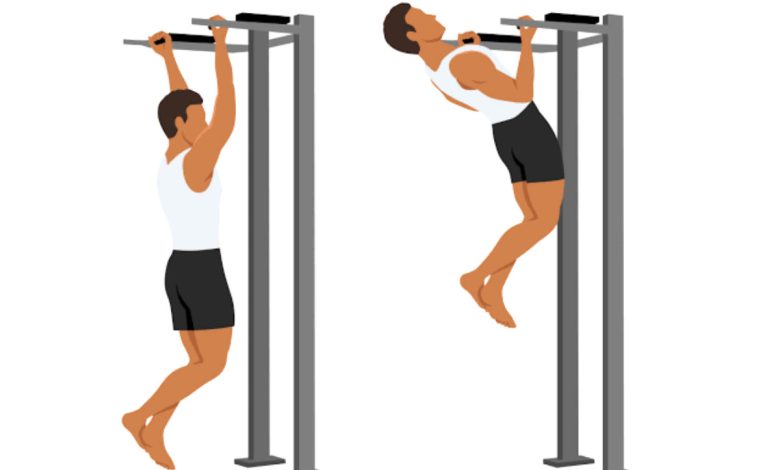Pull up Exercise: A Comprehensive Guide and Benefits

(Health Benefits of Pull up Exercise)
The pull-up, a seemingly simple yet incredibly challenging exercise, has been a staple in strength training for decades. This compound movement, which requires you to lift your entire body weight, engages multiple muscle groups, making it a highly effective way to build upper body strength and improve overall fitness.
Understanding the Pull-Up
Before we delve into the benefits, let’s clarify what a pull-up is. It’s a calisthenic exercise that involves hanging from a bar with an overhand grip, then pulling yourself up until your chin clears the bar. The primary muscles worked in a pull-up include:
- Latissimus dorsi (lats): The large, fan-shaped muscles on the sides of your back that are responsible for pulling your arms towards your body.
- Biceps: The muscles on the front of your upper arm that flex your elbow.
- Forearms: The muscles in your lower arm that help with gripping.
- Trapezius (traps): The diamond-shaped muscles that run from the base of your neck to your shoulders.
- Rhomboids: The muscles between your shoulder blades that help retract your shoulders.
The Benefits of Pull-Up Exercise
Pull-up exercise have multiple health benefits. Here are some very useful and important benefits for the body.
1.Enhanced Upper Body Strength
Compound movement: Pull-ups are a compound exercise, meaning they work multiple muscle groups simultaneously. This makes them highly efficient for building overall upper body strength.
Full-body engagement: Even though they primarily target the upper body, pull-ups also engage your core and legs for stability.
Progressive overload: As you get stronger, you can increase the difficulty of pull-ups by adding weight or performing them with one arm.
2.Improved Posture
Strengthened back muscles: Pull-ups strengthen the muscles that support your posture, including the lats, rhomboids, and traps.
Counteract poor posture: Many people spend long hours sitting, which can lead to poor posture. Regular pull-ups can help counteract this by strengthening the muscles that pull your shoulders back.
3.Increased Functional Fitness
Everyday tasks: Pull-ups are a functional exercise, meaning they mimic movements you perform in everyday life, such as pulling yourself up into a chair or climbing a ladder.
Athletic performance: Pull-ups are essential for many sports, including rock climbing, gymnastics, and martial arts.
4.Improved Grip Strength
Essential for many activities: Grip strength is important for many activities, from carrying heavy objects to playing musical instruments.
Strengthened forearms: Pull-ups help strengthen your forearms, which are essential for grip strength.
5.Boosted Confidence
Sense of accomplishment: Being able to perform a pull-up is a significant accomplishment for many people, which can boost their confidence and self-esteem.
Positive impact on mental health: Regular exercise has been shown to have a positive impact on mental health, and the sense of achievement from performing pull-ups can be particularly beneficial.
Mastering the Pull-Up: Techniques and Progressions
Proper form: It’s essential to maintain proper form during pull-ups to prevent injuries and maximize benefits. Your body should be straight, and your legs should be crossed or together.
Overhand grip: The most common grip for pull-ups is an overhand grip, with your palms facing away from you. However, you can also try an underhand grip or a neutral grip.
Chin over the bar: The goal of a pull-up is to pull your chin over the bar. Don’t swing your legs or body to assist yourself.
Negative reps: If you can’t do full pull-ups, start with negative reps. This involves jumping up to the top position and then slowly lowering yourself down.
Assisted pull-ups: You can use a resistance band or a pull-up machine to assist yourself with pull-ups.
Build strength gradually: It takes time to build the strength necessary to perform pull-ups. Start with easier variations and gradually increase the difficulty as you get stronger.
Common Mistakes and How to Avoid Them
Swinging: Avoid swinging your body or legs to assist yourself. This can make the exercise easier but also increase your risk of injury.
Rounding your back: Keep your back straight and avoid rounding it during the pull-up. This can put strain on your lower back.
Not engaging your core: Your core muscles play a vital role in stabilizing your body during pull-ups. Engage your core throughout the movement.
Overtraining: Avoid overtraining, as this can lead to injuries and burnout. Give your muscles time to recover between workouts.
Incorporating Pull-Ups into Your Workout
Routine
- Frequency: Aim for 2-3 workouts per week that include pull-ups.
- Sets and reps: Start with 3 sets of as many reps as you can do. As you get stronger, increase the number of sets or reps.
- Variety: Incorporate different variations of pull-ups, such as wide-grip, narrow-grip, and weighted pull-ups, to target different muscle groups and prevent plateaus.
- Rest: Allow your muscles to recover between workouts.
Pull-Up Variations: Expanding Your Workout Routine
While the standard pull-up is a great exercise, incorporating variations can help you target different muscle groups, prevent plateaus, and make your workouts more interesting. Here are some popular pull-up variations to consider:
Grip Variations
Wide-grip pull-up: This variation targets the lats more than the biceps. Place your hands wider than shoulder-width apart on the bar.
Narrow-grip pull-up: This variation primarily targets the biceps. Place your hands closer than shoulder-width apart on the bar.
Neutral-grip pull-up: This variation is a good balance between the wide-grip and narrow-grip pull-ups. Use parallel bars or a neutral-grip pull-up bar.
Weight Variations
Weighted pull-up: Add weight to your pull-ups to increase the resistance and challenge your muscles. You can use a weight belt or a weighted vest.
One-arm pull-up: This is a highly challenging variation that requires exceptional upper body strength. Start by performing assisted one-arm pull-ups using a resistance band.
Other Variations
Towel pull-up: This variation requires more grip strength. Hang two towels over a bar and grab the ends. Pull yourself up using the towels.
L-sit pull-up: This variation requires core strength and balance. Hold an L-sit position with your legs straight out in front of you while performing the pull-up.
Muscle-up: This advanced variation involves pulling yourself up to the bar, then pushing yourself into a handstand position.
Tips for Progressing Your Pull-Ups
Start with easier variations: If you can’t perform full pull-ups, start with easier variations, such as assisted pull-ups or negative reps.
Gradual progression: Gradually increase the difficulty of your pull-ups as you get stronger. This could involve adding weight, performing more reps, or trying more challenging variations.
Consistency is key: Regular practice is essential for improving your pull-up performance. Aim for 2-3 workouts per week that include pull-ups.
Proper form: Always maintain proper form to prevent injuries and maximize the benefits of your workouts.
Rest and recovery: Give your muscles time to recover between workouts. Adequate rest is essential for building strength and preventing overtraining.
Overcoming Common Pull-Up Challenges
Lack of strength: If you’re struggling to perform pull-ups, focus on building your upper body strength through other exercises, such as rows, bicep curls, and tricep extensions.
Limited grip strength: Improve your grip strength by performing exercises like farmer’s walks, deadlifts, and rock climbing.
Poor posture: Good posture is essential for performing pull-ups effectively. Make sure your back is straight and your shoulders are relaxed.
Plateaus: If you’re stuck at a plateau, try incorporating new variations or increasing the weight you’re using.
Conclusion
The pull-up is a versatile and challenging exercise that offers numerous benefits for your upper body strength, posture, functional fitness, and mental health. By following the techniques and progressions outlined in this article, you can gradually build the strength and endurance necessary to master this impressive feat. Remember, consistency is key, so stick with it and enjoy the rewards of your hard work.




